
SciencephysicsMaterials Science
Hidden high-energy water reveals a new molecular force
TH
Thomas Green
13 hours ago7 min read1 comments
In the quiet, unseen spaces where molecules meet, a fundamental force has been hiding in plain sight, or rather, in water. Researchers from the Karlsruhe Institute of Technology (KIT) and Constructor University have pulled back the curtain on a startling molecular drama, revealing that water trapped within minuscule cavities is not a passive bystander but an intensely energetic actor, behaving with a pressure reminiscent of commuters crammed into a Tokyo subway car at rush hour.This isn't the placid H₂O of a serene lake; this is water in a state of extreme confinement, pushing outward with such ferocity that when a new molecule ventures into these nanoscale spaces, the pent-up water doesn't just leave—it erupts, forcing its way out and, in doing so, supercharging the molecular bond that forms in the void it vacates. Think of it as the molecular equivalent of a coiled spring, where the release of energy doesn't dissipate but is directly transferred to cement a new and stronger connection.This discovery, proven through a powerful synergy of meticulous experiment and robust theoretical modeling, fundamentally rewrites our understanding of intermolecular forces, suggesting that the 'solvent'—long considered a mere background medium—can be an active, energetic participant in chemical destiny. The implications ripple outward from this core finding, touching upon the very machinery of life itself.Within the labyrinthine folds of proteins, in the precise docking of a pharmaceutical drug to its target, or in the selective pores of cellular membranes, these highly energetic water molecules could be the unseen directors of biochemical processes, orchestrating interactions with a force we've only just begun to quantify. For decades, chemists and biologists have modeled these interactions with water as a kind of static buffer, but this research illuminates a dynamic landscape where the expulsion of a single, frantic water molecule can be the decisive factor in whether a bond holds or fails.It’s a paradigm shift as profound as realizing that the empty space in an atom isn't empty at all, but teeming with quantum potential. From a broader perspective, this work bridges a critical chasm between theoretical physical chemistry and practical application.The teams' ability to not only observe this effect but to accurately predict it with computational models opens a new frontier in rational drug design and materials science. Imagine engineering synthetic enzymes or designing next-generation catalysts where we don't just consider the shape of the molecules involved, but actively calculate the energetic contribution of the water we are about to evict.This could lead to pharmaceuticals with unprecedented specificity and potency, or to novel materials with self-healing properties guided by these controlled, water-driven forces. The research, while deeply fundamental, carries the distinct echo of a technological revolution, much like the discovery of quantum tunneling once did, revealing a subtle yet powerful mechanism that nature has been using all along. As we peer deeper into the nanoworld, it becomes clear that the most profound forces are often those we have overlooked, the quiet pushes and pulls in the spaces between, now revealed to be anything but quiet.
#featured
#molecular force
#high-energy water
#confined water
#KIT
#Constructor University
#research breakthrough
#chemistry
#physics
Stay Informed. Act Smarter.
Get weekly highlights, major headlines, and expert insights — then put your knowledge to work in our live prediction markets.
Related News
Comments
Loading comments...
© 2025 Outpoll Service LTD. All rights reserved.